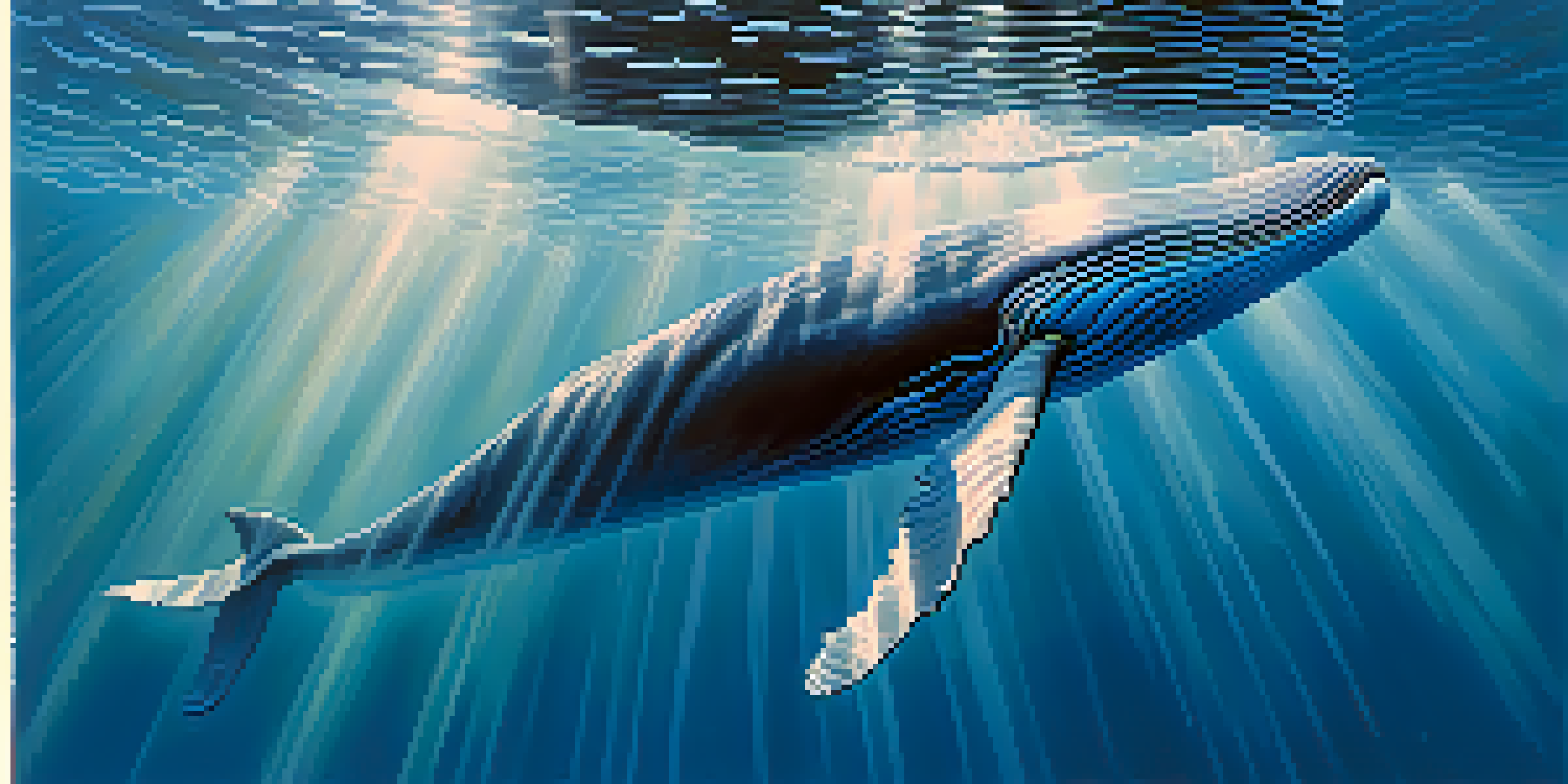The Different Types of Whales You Might Encounter

Introduction to the Enchanting World of Whales
Whales are some of the most magnificent creatures on our planet, often captivating the hearts of those who encounter them. With over 80 species across the globe, each whale has unique characteristics that make them special. From the massive blue whale to the agile orca, these gentle giants offer a glimpse into the rich biodiversity of our oceans.
Whales are the most graceful of creatures, reminding us of the beauty that exists in the natural world.
Whether you're a seasoned whale-watcher or a curious traveler, understanding the different types of whales can enhance your experience. Knowing what to look out for can make your journey more rewarding and educational. So, let's dive deeper into the world of whales and explore the various types you might encounter.
In this article, we'll cover the most common species of whales, highlighting their distinct traits, habitats, and behaviors. By the end, you'll have a better appreciation for these wonderful marine mammals and what makes each one unique.
The Majestic Blue Whale: The Largest Animal on Earth
The blue whale holds the title for being the largest animal on Earth, reaching lengths of up to 100 feet! These gentle giants are known for their striking blue-gray coloration and long, streamlined bodies. Blue whales primarily feed on tiny shrimp-like animals called krill, consuming up to 4 tons in a single day during feeding season.

You can often spot blue whales in deep ocean waters, particularly in the North Pacific and North Atlantic. They are known for their loud calls, which can be heard over great distances, aiding in communication and navigation. Their sheer size and grace are enough to leave any observer in awe.
Diverse Whale Species Enrich Oceans
With over 80 unique species, whales showcase the rich biodiversity of our oceans, each contributing to the marine ecosystem.
While sightings can be rare due to their migratory patterns, a blue whale encounter is truly unforgettable. Imagine watching one glide effortlessly through the water, a reminder of the ocean's vastness and the mysteries it holds.
The Graceful Humpback Whale: Known for Their Songs
Humpback whales are famous for their acrobatic displays and complex songs, which can last up to 20 minutes. These social creatures are often seen breaching the water's surface or slapping their fins, captivating anyone lucky enough to witness their behavior. Humpbacks can grow to about 50 feet and have distinctive long pectoral fins.
The ocean stirs the heart, inspires the imagination, and brings eternal joy to the soul.
These whales migrate long distances, traveling from feeding grounds in the polar regions to warmer breeding waters. This journey can span over thousands of miles, showcasing their incredible endurance. Humpback whales are often seen in coastal waters, making them a favorite among whale watchers.
Their haunting songs, which are believed to play a role in mating, add to their allure. Each population of humpbacks has its unique song, evolving over time and creating a fascinating cultural aspect among these marine mammals.
The Playful Orca: The Ocean's Clever Predators
Orcas, also known as killer whales, are actually the largest members of the dolphin family. They are easily recognizable by their striking black and white coloration, and they are highly social animals, often found in pods. Orcas are known for their intelligence and complex hunting techniques, making them formidable predators in the ocean.
These adaptable creatures can be found in a variety of marine environments, from icy polar regions to warm coastal waters. Their diet is diverse, including fish, seals, and even other whales, showcasing their versatility as hunters. Observing orcas in the wild is an exhilarating experience, as their playful nature often leads to spectacular displays.
Conservation is Crucial for Whales
Many whale species are threatened by human activities, making conservation efforts essential to protect these magnificent creatures.
Orcas communicate using a variety of vocalizations, which vary by pod and region. This social structure and communication system highlight their complex behavior and the strong bonds they form within their groups.
The Enigmatic Gray Whale: The Long-Distance Traveler
Gray whales are renowned for their remarkable migration journey, traveling up to 12,000 miles between their feeding and breeding grounds. These whales can reach lengths of about 50 feet and are often seen near the coast during their migration. Their unique mottled gray skin and barnacle-covered bodies make them easily identifiable.
During migration, gray whales often travel along the California coast, providing excellent opportunities for whale watchers. They are known for their curious nature and can often be seen swimming close to boats. This behavior allows for a thrilling experience for those lucky enough to be on the water.
Gray whales primarily feed on small organisms found on the ocean floor, using a technique called benthic feeding. They are a great example of the incredible journeys some whale species undertake, demonstrating the resilience and adaptability of these marine mammals.
The Mighty Sperm Whale: The Deep-Sea Diver
Sperm whales are known for their impressive diving capabilities, capable of reaching depths of over 3,000 feet in search of squid. These deep-sea divers are the largest toothed whales, with males growing up to 60 feet long. Their distinctive block-shaped heads and prominent teeth make them easily recognizable.
Sperm whales are often found in deep ocean waters, where they hunt for their prey. Their social structure is unique, as females and young males typically form pods, while larger males tend to be solitary. This fascinating social dynamic adds to the intrigue of these remarkable creatures.
Whale Watching Enhances Awareness
Engaging in whale watching not only provides unforgettable experiences but also fosters a deeper appreciation for marine life.
The echolocation abilities of sperm whales allow them to navigate and hunt effectively in the dark depths of the ocean. This adaptation highlights their complexity and the evolutionary traits that enable their survival in challenging environments.
The Distinctive Bowhead Whale: Arctic Adaptations
Bowhead whales are known for their thick blubber and large baleen plates, which help them filter feed on tiny organisms in the icy Arctic waters. They can grow up to 60 feet long and are easily recognized by their bow-shaped heads. These whales are well adapted to their cold environment, with a layer of blubber that can be over a foot thick.
Bowhead whales are often found near the ice edge, where they feed on zooplankton and other small marine life. Their ability to break through ice makes them unique among baleen whales. They are also known for their long lifespan, with some individuals living over 200 years.

While bowhead whales were once heavily hunted, conservation efforts have helped their populations recover. Observing these magnificent whales in their natural habitat is a reminder of the importance of protecting our oceans and the creatures that inhabit them.
Conclusion: The Importance of Whale Conservation
As we conclude our journey through the fascinating world of whales, it's important to recognize the significance of conservation efforts. Many whale species face threats from habitat loss, climate change, and hunting, making our awareness and support crucial. Understanding these majestic animals fosters a deeper appreciation for the marine environment and encourages responsible tourism.
By participating in whale watching or supporting marine conservation organizations, we can contribute to the protection of these incredible creatures. Every encounter with a whale can inspire a sense of wonder and a desire to preserve their habitats for future generations.
Let’s continue to celebrate and protect the diverse types of whales that grace our oceans. Together, we can ensure that these magnificent mammals thrive and continue to enchant those who seek to witness their beauty in the wild.